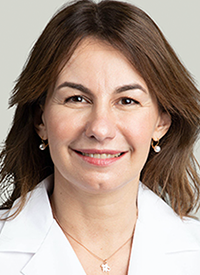KEYNOTE-189 Analysis Supports Pembrolizumab/Chemo as a Frontline Standard in Metastatic NSCLC
Five-year follow-up data from the phase 3 KEYNOTE-189 trial further confirms the use of first-line pembrolizumab in combination with pemetrexed and platinum improves long-term survival outcomes for patients with treatment-naïve, metastatic, nonsquamous non–small cell lung cancer.
Marina Chiara Garassino, MD

Five-year follow-up data from the phase 3 KEYNOTE-189 trial (NCT02578680) further confirms the use of first-line pembrolizumab (Keytruda) in combination with pemetrexed (Alimta) and platinum improves long-term survival outcomes for patients with treatment-naïve, metastatic, nonsquamous non–small cell lung cancer (NSCLC), according to Marina Chiara Garassino, MD.
Updated analysis presented at the 2022 ESMO Congress showed that patients treated with pembrolizumab maintained a prolonged overall survival (OS) and progression-free survival (PFS) benefit compared with those in the placebo arm.
Median OS was 22.0 months (95% CI, 19.5-24.5) in the pembrolizumab arm vs 10.6 months (95% CI, 8.7-13.6) in the placebo group (HR, 0.60; 95% CI, 0.50-0.72). Five-year OS rates were 19.4% and 11.3% respectively. Additionally, median PFS increased from 4.9 months (95% CI, 4.7-5.5) in the placebo arm to 9 months (95% CI, 8.1-10.4) with pembrolizumab (HR, 0.50; 95% CI, 0.42-0.60).
The toxicity profile was consistent with previous findings, with 52.3% of patients in the pembrolizumab arm experiencing grade 3 or higher treatment-related adverse effects (AE) vs 42.1% of patients in the placebo arm.
Additionally, patients who completed a full 35 cycles of pembrolizumab (n = 57) exhibited a durable response, with a 3-year OS rate of 71.9% and an overall response rate of 86% (95% CI, 74.2%-93.7%).
“The results showed that at least [19.4%] of patients [treated with pembrolizumab plus chemotherapy have] survived for 5 years,” said Garassino, who is a professor of medicine, hematology and oncology in the Department of Medicine, and director of the Thoracic Oncology Program at the University of Chicago in Illinois. “When I started my career, that was not possible. We [also] know [that] the [treatment regimen] was completed in a good [number] of patients without [AEs] leading to treatment discontinuation. [That’s very] good news.”
In an interview with OncLive®, Garassino discussed unique aspects of the KEYNOTE-189 trial design, key findings from the 5-year follow-up analysis, and the positive effect of chemoimmunotherapy combinations on patient outcomes.
OncLive®: Please provide some background on the initial effects of the KEYNOTE-189 trial.
Garassino: KEYNOTE-189 was practice-changing for patients with advanced, nonsquamous NSCLC. [It] was a [randomized] phase 3 trial [comparing] the combination of chemotherapy and pembrolizumab [with placebo plus] chemotherapy. At the time, [standard chemotherapy] was a combination of cisplatin or carboplatin and pemetrexed.[The trial] enrolled patients with advanced NSCLC without EGFR or ALK alterations.
What was the rationale for evaluating the addition of pembrolizumab to standard pemetrexed-platinum chemotherapy for patients with nonsquamous NSCLC?
Chemotherapy can remove the myeloid-suppressor components, [while also inducing] immunogenic cell death. [This] activates the T cells, [bolstering] the efficacy of immunotherapy. [We knew that] chemotherapy and immunotherapy work well together, so [we wanted to investigate the efficacy of this combination] in the first-line setting.
What is important to note about the trial design?
When the trial was conceived, immunotherapy was already present in the [treatment] landscape of NSCLC. [Because of this], crossover [from placebo to anti–PD-L1 therapy] was allowed. The [effective crossover rate] was 57%, [which] means that [118] patients received [subsequent] immunotherapy. [This is important because] the results [confirm an] increase [in] OS [benefit despite the] 57% of patients [who] received that immunotherapy as a second-line treatment.
What key findings from the 5-year follow-up analysis stood out to you?
[During our follow-up analysis], there [was] a group of patients who completed the [full] 35 cycles of [chemoimmunotherapy, which is equivalent to] two years of treatment. The treatment was well tolerated [in] these patients and [AEs were consistent with] what we had [observed] in the past. [This indicates that] the treatment is feasible for 2 years. For those patients who [completed] 2 years of treatment, there was [also] a very high life expectancy. [In fact,] a huge proportion of patients were still alive 3 years [after completion] and 5 years [from randomization].
We thought [there might be] a crossing of the [Kaplan-Meier] curves at the [time of cut-off]. [However, we saw that] the benefit of the chemotherapy and immunotherapy is very well maintained, [and that the] tail of the curves with the combination of chemotherapy and immunotherapy [began to plateau]. That is something that we really wanted to see in this trial.
How might these updated findings affect expectations for future treatment for this patient population?
KEYNOTE-189 already represented the standard of care for patients with advanced NSCLC and nonsquamous histology, and [immunotherapy] is already [prolific in most treatment strategies.]Clearly, we have to [keep raising] the bar [for patient survival, but] the [effect of this] treatment is visible. I hope that research [in this area] will [continue], and that patient survival [rates will] exceed [current] expectations [even] more than what we can see now.
Reference
Garassino MC, Gadgeel SM, Speranza G, et al. KEYNOTE-189 5-year update: first-line pembrolizumab (pembro) + pemetrexed (pem) and platinum vs placebo (pbo) + pem and platinum for metastatic nonsquamous NSCLC. Ann Oncol. 2022;33(suppl 7):S992-S993. doi:10.1016/j.annonc.2022.07.1101



